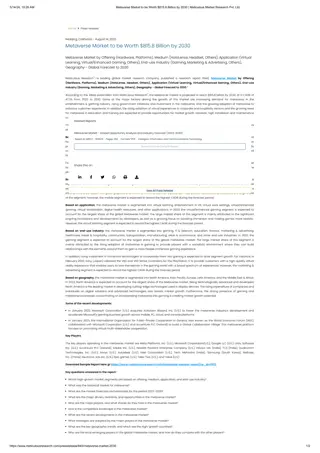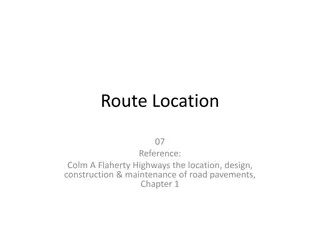The Road to Metaverse Interoperability: Challenges and Solutions
Metaverse standards and interoperability are crucial for unleashing the full potential of this transformative technology. However, the lack of common agreement on what a metaverse entails poses challenges. The MPAI roadmap addresses key steps towards achieving interoperability, including developing functionality profiles and architectural requirements. Embracing diverse perspectives and functionalities will be essential in shaping the future of the metaverse.
Download Presentation

Please find below an Image/Link to download the presentation.
The content on the website is provided AS IS for your information and personal use only. It may not be sold, licensed, or shared on other websites without obtaining consent from the author.If you encounter any issues during the download, it is possible that the publisher has removed the file from their server.
You are allowed to download the files provided on this website for personal or commercial use, subject to the condition that they are used lawfully. All files are the property of their respective owners.
The content on the website is provided AS IS for your information and personal use only. It may not be sold, licensed, or shared on other websites without obtaining consent from the author.
E N D
Presentation Transcript
MPAI Metaverse Model S. Casale-Brunet, 2023 March 31 T 07:40 & 18:20 1 6-Sep-24
Metaverse and standards Metaverse is expected to create new jobs, opportunities, and experiences with transformational impacts on virtually all sectors of human interaction. Metaverse standards are important, but: There is no common agreement on what a metaverse is or should be. There are many potential users of the metaverse. There are many successful independent implementations of metaverse . Some important enabling technologies may be years away. We need to agree on how to tackle metaverse standardisation, without: Alienating existing initiatives. Necessarily agreeing what a metaverse is. Necessarily dealing with technologies (for now). Disenfranchising potential users. 2 6-Sep-24
The MPAI roadmap to Metaverse interoperability 1. Build a metaverse terminology done. 2. Agree on basic assumptions done 3. Collect metaverse functionalities done 4. Develop functionality profiles almost done. 5. Develop a metaverse architecture. 6. Develop functional requirements of the metaverse architecture data types. 7. Develop the Table of Contents of the Common Metaverse Specifications. 8. Map technologies to the ToC of the Common Metaverse Specifications. 3 6-Sep-24
The starting point As there is no agreement on what a metaverse is and what it should do, let s accept all legitimate requests of metaverse functionalities. Note: an accepted functionality does not imply that an M-Instance shall support it. Profiles will be defined by grouping similar application areas is A set of one or more base standards (and, If applicable, their chosen classes, subsets, options and parameters) Necessary for accomplishing a particular function. While we do not have technologies, let s develop functionality profiles. Set of functionalities offered, not set of technologies implementing them. 4 6-Sep-24
Technical Report MPAI Metaverse Model (MPAI-MMM) Functionality Profiles. MPAI has published: Technical Report MPAI Metaverse Model (MPAI-MMM) Functionalities. MPAI is now developing: Technical Report MPAI Metaverse Model (MPAI-MMM) Functionality Profiles. Table of contents 1. Metaverse operational model 2. Basic elements: 1. Actions 2. Items 3. Data Types 3. Use Cases 4. Functionality Profiles. 5 6-Sep-24
Universe M-Environment Pers. Pers. U-Environment Object User M-Instance App Object object Service Actuators Metaverse Server1 Device Sensors M-Environment U-Location Object object Object App User User Actuators human1 Service Device Sensors M-Environment U-Location User Object U-Environment Object M-Instance User Metaverse Server2 Service App U-Environment Device Sensors M-Environment Actuators human2 User Object U-Location Object User 6 6-Sep-24
MPAI-MMM basics An M-Instance may ask a human to Register providing User Data and obtain an Account. A User, a Process representing a human with an Account represented as a Persona MM-Embedded and UM-Animated by a Stream or MM-Animated by an autonomous agent to join the M-Instance. A User should comply with the Rules expressing the terms & conditions under which a User exists and operates. A User will exercise Rights that express its ability to perform an Action (an operation performed on an Item (Data and Metadata recognised by an M-Instance. Service: a Process offering functionalities for the functioning of an M-Instance. Device: a Process having either or both the capabilities to: UM-Send (i.e., acquire Media from a U-Location) UM-Stream Data from the Device to a User, and/or receive MU-Streamed Entities MU-Send Media at a U-Location with a Spatial Attitude. 7 6-Sep-24
Actions Function whose execution is requested on an Item Authenticate Interpret Author MM-Add Call MM-Animate Change MM-Capture Create MM-Enable Destroy MM-Embed Discover MM-Remove Inform MM-Render MM-Send MU-Render MU-Send MU-Stream Post Read Register Track Transact UM-Animate UM-Capture UM-Render UM-Send UM-Stream Write MM = Action performed in the Metaverse MU = Action performed from the Metaverse to the Universe UM = Action performed from the Universe to the Metaverse 8 6-Sep-24
Action Request Format Payload of the request made by a Source to a Destination Process (ID=ProcessID) (User-Device-Service) Destination Process (ID=ProcessID) (User-Device-Service) Action Act InItem Item (ID=ItemID) InLocation M-LocationID U-LocationID Service (ID=ServiceID) OutItem Item (ID=ItemID) OutLocation M-LocationID U-LocationID Process (ID=ProcessID) OutRights Rights (ID=RightsID) Source 9 6-Sep-24
Action Response Format Success Action result Item location Parameter Request IDs Rights Unsupported Mismatch User Data Wallet Clash M-Location U-Location Address Item (ID=ItemID) Service (ID=ServiceID), M-Location, U-Location Item1(ID=ItemID1) Faulty Incorrect Missing or incomplete Item Format not supported Item type mismatch Faulty Insufficient Value Entity clashes with another Entity Out of range Out of range Incorrect Error 10 6-Sep-24
Items Data with a Format recognised by the M-Instance M-Instance Request-Discover M-Location Request-Inform Map Request-Interpret Message Response-Authenticate Transaction Model Response-Discover Object Response-Inform Personal Profile Response-Interpret Process Rights Provenance Rules M-Environment Request-Authenticate Scene Account Activity Data App Asset Device Event Experience Identifier Interaction Service Social Graph Stream U-Location User User Data Value Wallet 11 6-Sep-24
Item Metadata Metadata ItemID UserID WalletID InRightsID OutRightsID AuthorID AuthorToolID ParentItemID ServiceID ServiceWalletID ActedOnItemID TargetUserID TargetWalletID UserDataID PersonaID PersonalDataID ActivityDataID Descriptive Metadata Semantics ID of the Item. ID of the User who holds Rights on the Item with ItemID. ID of the Wallet held by User with UserID ID of the Rights the User with UserID has on the Item with ItemID. ID of the Rights a User may acquire on the Item with ItemID. ID of the User who Authored the Item with ItemID. ID of the Service who provided the AuthorTool. ID of the Item that spawned the Item. ID of the Service that is Called. ID of the Wallet of a Service. ID of the Item that was Acted on. ID of the User to be affected by the Action. ID of the Wallet of the User to be affected by the Action. ID of a User Data. ID of a User s Persona. ID of a User s Personal Data. ID of a User s Activity Data. Any additional descriptive Metadata of the Item. 12 6-Sep-24
Data Types Data Types are data formats used by Actions and Items Address Amount Cognitive State Coordinates Currency Emotion Orientation Personal Status Point of View Position Social Attitude Spatial Attitude Time 13 6-Sep-24
Authors VRoom1.1 Virtual Lecture Use Case MM-Embeds VRoom1.1@ML1.1 Authors Persona2.1 Tracks Persona2.1 @ML2.1 Transacts Value2.1 MM-Embeds Persona2.1 @ML2.2 Authenticates Persona1.1 MM-Removes Persona2.1 @ML2.1 Writes @Experience2.1 Authors Persona3.1 Tracks Persaona3.1 @ML3.1 MM-Embeds Persona3.1 @ML3.2 Authenticates Persona3.1 MM-Removes Persona3.1 @ML3.1 MM-Embeds 3DModel3.1 @ML3.3 Calls Service3.1 Transacts Value1.1 MM-Embeds Persona3.1@ML3.1 MM-Embeds Persona2.1@ML2.1 MM-Removes Persona3.1 @ML3.2 MM-Removes Persona2.1 @ML2.2 14 6-Sep-24
Baseline Profile: Functionalities The Baseline Functionality Profile enables a human equipped with a Device to execute Basic and Composite Functions: High Profile 1. Author Entity, e.g., an Object Model. Management Profile 2. Embed an Object at an M-Location. 3. Track an Object Baseline Profile Finance Profile 4. Remove an Object. 15 6-Sep-24
Next Steps 1. Technical Specification MPAI Metaverse Model (MPAI-MMM) Architecture (August) 2. Technical Report MPAI Metaverse Model (MPAI- MMM) Data Type Functional Requirements (October) 3. Table of Contents of Metaverse Technology Specifications (November) 4. Table of Contents of Metaverse Technology Specifications including MPAI standard Technologies (December) 16 6-Sep-24
Join MPAI Share the fun Build the future! We look forward to your participation in this exciting project! https://mpai.community/ 17 6-Sep-24























